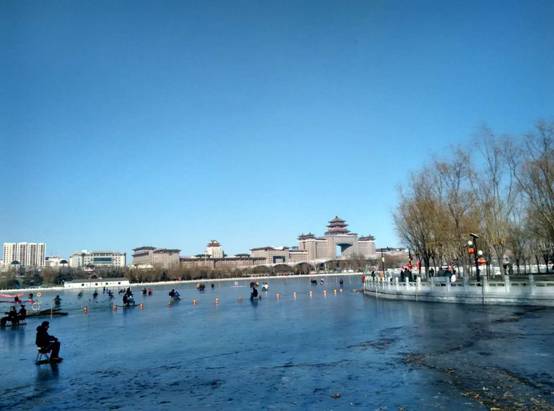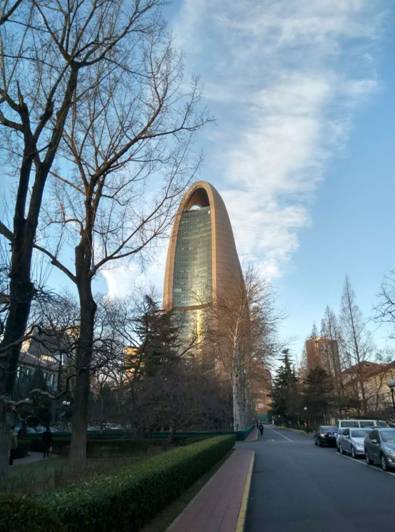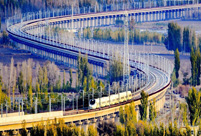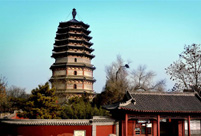


Beijing citizens enjoy the ice during the winter of 2015. (Photo: Du Yifei from People’s Daily)
As China’s latest effort to address her environmental woes, the country gave emphasis to environmental conservation in its new government work report. Thanks to a wide range of efforts by the Chinese government and people, the nation’s battle against environmental pollution is heading towards victory.
In her annual government work report delivered on Saturday, China’s Premier Li Keqiang urged to step up environmental governance efforts and work to see breakthroughs in green development.
"We must work to build, through tireless efforts, a beautiful China where the sky is blue, the land is green, and the water runs clear,” he said, showing the determination of the Chinese government to declare war against environmental pollution.
According to statistics from the Ministry of Environmental Protection , Beijing recorded 186 days of air quality "up to par" in 2015, 14 days more than the year before.
The annual average density of PM2.5 in Beijing, or particulate matter that causes hazardous smog, stood at 80.6 micrograms per cubic meter, a year-on-year decrease of 6.2 percent, the ministry said.
“Beijing had lovely weather this winter. I could always see the blue sky and clouds. The air quality in this year is much better than last year,” said a Beijing citizen Zhang Hai.
The achievement can be attributed to several actions China undertook in recent years for fighting pollution.
The new Environmental Protection Law that has taken effect in 2015, for example, imposes more severe punishments on polluters.
As of the end of 2015, environmental authorities at all levels had issued punishments in 97,000 cases, collecting 4.25 billion Yuan ($650 million) in fines, an increase of 34 percent year-on-year.
In September 2015, China issued the Integrated Reform Plan for Promoting Ecological Progress, laying out top-level design for ecological reform.
Besides legislative support, China has also identified the task of eliminating outdated industrial capacity during its 12h Five-Year plan, which was finished one year ahead of schedule.
As a result, industrial pollution discharge was cut down. For example, the emission of sulfur dioxide and nitrogen oxides from thermal power plants dropped by 47 percent and 50 percent respectively.
Covering 1.47 million square kilometers, or 14.8 percent of her territory, China's natural reserves act as a safe haven for 85 percent of its wildlife and plant life.
Wu Shunze, vice president of the Chinese Academy for Environmental Planning, said that China has preliminarily completed the construction of pollution treatment facilities, and early harvests have been reaped.
China has passed its most difficult time and has now entered a critical stage where positive factors accumulate, he added.
But the country still has a long way to go to address the roots of these issues. Some mechanism-related problems still hinder environmental protection efforts, and certain areas need to focus more on green development.
The public believes that governmental policy and the will of the people will push China towards an ecologically civilizational nation.

Picture is the new headquarter of People's Daily under a blue sky. (Photo: Du Yifei from People's Daily)
 China has world's largest high-speed rail network
China has world's largest high-speed rail network Top beauties in Chinese provinces
Top beauties in Chinese provinces 600 people attend Lusheng playing contest in S China
600 people attend Lusheng playing contest in S China Engineer troop builds bridge in real combat conditions
Engineer troop builds bridge in real combat conditions You can urinate in public in Chongqing
You can urinate in public in Chongqing Rice terrace scenery in southwest China's Yunnan
Rice terrace scenery in southwest China's Yunnan 2016 Miss Chinatown USA pageant held in San Francisco
2016 Miss Chinatown USA pageant held in San Francisco Ancient pagodas across China
Ancient pagodas across China Wedding dress show up in the air
Wedding dress show up in the air Top 20 hottest women in the world in 2014
Top 20 hottest women in the world in 2014 Top 10 hardest languages to learn
Top 10 hardest languages to learn 10 Chinese female stars with most beautiful faces
10 Chinese female stars with most beautiful faces China’s Top 10 Unique Bridges, Highways and Roads
China’s Top 10 Unique Bridges, Highways and Roads Deficit rise can aid growth: minister
Deficit rise can aid growth: minister Washington-Seoul drills escalate tensions
Washington-Seoul drills escalate tensions China’s hottest foreign musicians share their stories
China’s hottest foreign musicians share their stories Feminism ‘doesn’t fit China,’ says the country’s first women’s bookstore owner
Feminism ‘doesn’t fit China,’ says the country’s first women’s bookstore ownerDay|Week